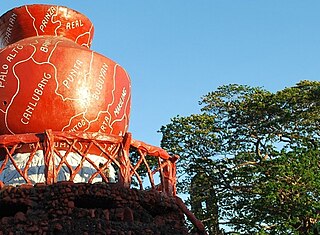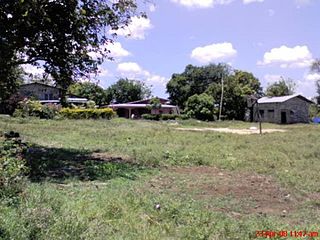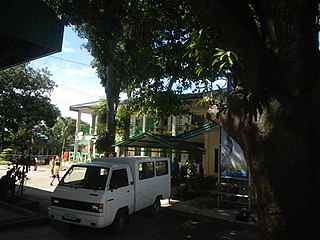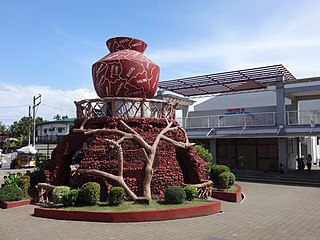Rock most often refers to:

The Kalinago, also known as the Island Caribs or simply Caribs, are an indigenous people of the Lesser Antilles in the Caribbean. They may have been related to the Mainland Caribs (Kalina) of South America, but they spoke an unrelated language known as Island Carib. They also spoke a pidgin language associated with the Mainland Caribs.
Carmel in the Bible refers to two distinct places:

Laguna, is a province in the Philippines located in the Calabarzon region in Luzon. Its capital is Santa Cruz and the province is situated southeast of Metro Manila, south of the province of Rizal, west of Quezon, north of Batangas and east of Cavite. Laguna hugs the southern shores of Laguna de Bay, the largest lake in the country. As of the 2015 census, the province's total population is 3,035,081 . It is also currently the seventh richest province in the country.
The music of Belize has a mix of Creole, Mestizo, Garìfuna, Mayan and European influences.

The Garifuna people are a mixed African and indigenous people originally from the Caribbean island of Saint Vincent who speak Garifuna, an Arawakan language.

Calamba, officially the City of Calamba, is a 1st class component city in the province of Laguna, Philippines. According to the 2015 census, it has a population of 454,486 people.

Punta is an Afro Indigenous dance and music originated by the Garifuna people with African and Arawak elements.

Cabuyao, officially the City of Cabuyao, is a 1st class component city in the province of Laguna, Philippines. According to the 2015 census, it has a population of 308,745 people.

Costa da Morte is part of the Galician coast. The Costa da Morte extends from the villages of Muros and Malpica.

Punta Arenas is the capital city of Chile's southernmost region, Magallanes and Antartica Chilena. The city was officially renamed as Magallanes in 1927, but in 1938 it was changed back to "Punta Arenas". It is the largest city south of the 46th parallel south, and at the same time the most populous southernmost city in Chile and in the Americas, and due to its location, the coldest coastal city with more than 100,000 inhabitants in Latin America. It is also one of the most populous sites so far south in the world.

Kay-Anlog is a component barangay of the city in Calamba, Laguna, Philippines, situated in the southern part of the city, adjacent to the barangays of Milagrosa, Burol, Bubuyan, and Ulango.

Yungay district is a district in the Province of Yungay in the Ancash region, Peru. It was created by law on October 28, 1904.

Punta Integrated School formerly known as Punta National High School is a public high school in Punta, Calamba City, Laguna, Philippines. It offers both junior high school and senior high school.

Punta is a rural barangay of Calamba City, Laguna in the Philippines. It is situated in the central-south portion of the city.

Asian Computer College is a private, non-sectarian institution of higher learning with two campuses in Calamba City in the Philippines. It was founded in 2000 as technical school offering short computer courses with basic education.

Barandal is an industrial barangay of the city of Calamba in the province of Laguna, Philippines. It is geographically situated in the middle of the city. It houses various residential areas like Amaia Scapes by Ayala Land, Vista Hills by Filinvest Land, Calamba Hills Village Phase 2 by TESCO, Crescent Knoll by Major Homes, Laguna Buenavista Executive Homes by TESCO, Carmel Village Phase 2, Chateau Milano by TESCO, Andrea Paz Subdivision, and GK-Philipps Pabahay. The barangay is also the location of several companies in the Calamba Premier Industrial Park (CPIP).

CALAMBANGA, also known as the Calamba Jar or Calamba Claypot, is a landmark in Calamba, Laguna, Philippines believed to be the largest claypot in the world. It is located at the City Plaza near Calamba Church and Rizal Shrine. Built in 1937, it is constructed to illustrate and immortalize the folk tale on how the city got its name with the names of the city's barangays inscribed on its surface. The giant claypot can also be found in the city's official seal.

Matang Tubig is a cold spring and tourist spot in Laguna, Philippines it is bounded by Cabuyao and Calamba cities. It slopes to the foot of Casile Valley. The Matang Tubig water source is from Tagaytay City in the province of Cavite, The cave is close adjacent beside in Canlubang Golf & Country Club, along the valley fault.
The Tagaytay–Calamba Road is a two- to four-lane, secondary and tertiary road in Laguna and Cavite, Philippines. It connects the city of Calamba in Laguna and the city of Tagaytay in Cavite.














